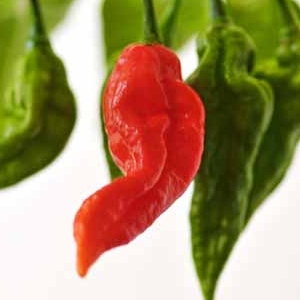Chili peppers may be the oldest food we eat that still exists in more or less the same form as it did 50 million years ago. How have chilis’ lasted so long? Researchers at the University of Colorado have some theories – and I have mine…
 Fossil of a Chili Pepper calyx estimated to be 50 million years old. How has the chili
Fossil of a Chili Pepper calyx estimated to be 50 million years old. How has the chili
survived, more or less as it started, for such an unimaginably long time?
Researchers at University of Colorado Boulder found the previously overlooked fossil when studying something completely different. The tiny stem-and-cap shaped object was just there, at the edge of a much larger fossil’s background slab.
When I first read the headline, I thought it said ‘5o thousand year old chili pepper stem’. Honestly. My brain just saw the world ‘million’ and rejected it out of hand because that was such an unimaginably long time. Nevertheless, that’s what it said. no mistake.
Prior to the recent fossil discovery, scientists had believed that the chili pepper originated in South America 10 to 15 million years ago. It was postulated that birds had eaten he fruit and dispersed the seeds across the world from there. But… “These chili peppers, a species that we thought arose in an evolutionary blink of an eye, have been around for a super long time,” admits Dr. Stacey Smith. “We’re still coming to grips with this new timeline.”
A big family, and they circulated…
According to an abstract of the study on the ancient chili, The chili pepper belongs to the nightshade family, a large group comprising species as varied as peppers, tomatoes and potatoes.
The nightshade family comprises 3,000 species and almost 100 different genera, including chili peppers. The ancient chili pepper was technically a fruit—and a berry, at that. While tomatoes and peppers are commonly associated with vegetables, they have seeds on the inside, which officially categorizes them as fruits.
The researchers cannot be sure of the chili’s exact shape or color, but it was probably on the smaller end compared to modern day chili peppers. Also, like its relatives, it could have been ‘quite spicy’, says Dr. Rocio Deanna.
“The world has maybe 300,000 plant species. The only plants with that kind of calyx is this group of 80 or 90 species,” says Smith, senior author of the paper and associate professor of evolutionary biology at CU Boulder.
My take
In as much as the team postulates that, “fruit-eating birds, which existed as early as 60 million years ago, may have carried seeds and plants around the world,” I wonder how the birds could have stood to eat the blessed flaming things in the fist place. After all, as Deanna says, the ancient chili, “could have been quite spicy,” even in comparison to the chilis we know today. The researchers do have a fall-back proposition, mind you: the seeds could have stuck to the birds’ feet or feathers by mud and would not have to have been eaten at all.
I have my own idea as to why the chili pepper has survived virtually unchanged to this day. It hasn’t HAD to evolve. It has no natural predators (thanks to its hefty, hot and spicy capsaicin load). Like the other nightshades, it could have thrived over a very wide range of climate zones. — And that’s a much more appealing theory than anything that has to do with dirty bird feet…
Now you’re fully up-to-date.
~ Maggie J.

